Abstract
Serum bactericidal activity against 20 strains of Pseudomonas aeruginosa was studied in 10 volunteers after administration of imipenem (25 mg/kg), imipenem (25 mg/kg) plus amikacin (7.5 mg/kg), and ceftazidime (25 mg/kg) plus amikacin (7.5 mg/kg). Eight strains were susceptible and 12 were resistant to ticarcillin. Serum levels were measured microbiologically after 30 and 60 min and were, respectively, 97 and 46 micrograms/ml for imipenem given alone and 79 and 45 micrograms/ml for imipenem given with amikacin. Despite the very large dose of imipenem used, imipenem and imipenem plus amikacin appeared slightly less active than ceftazidime plus amikacin (P less than or equal to 0.1; Wilcoxon matched-pairs test), with respective median titers at 30 min of 1:128, 1:128, and 1:256 against ticarcillin-susceptible strains and 1:32, 1:32, and 1:64 against ticarcillin-resistant strains; however, more than 90% of the serum determinations, regardless of the regimen, had a serum bactericidal activity greater than or equal to 1:8. Amikacin significantly increased the rate of killing in serum of P. aeruginosa by imipenem. Imipenem plus amikacin appeared as effective as ceftazidime plus amikacin in reducing the viable counts of P. aeruginosa after 24 h of incubation.
Full text
PDF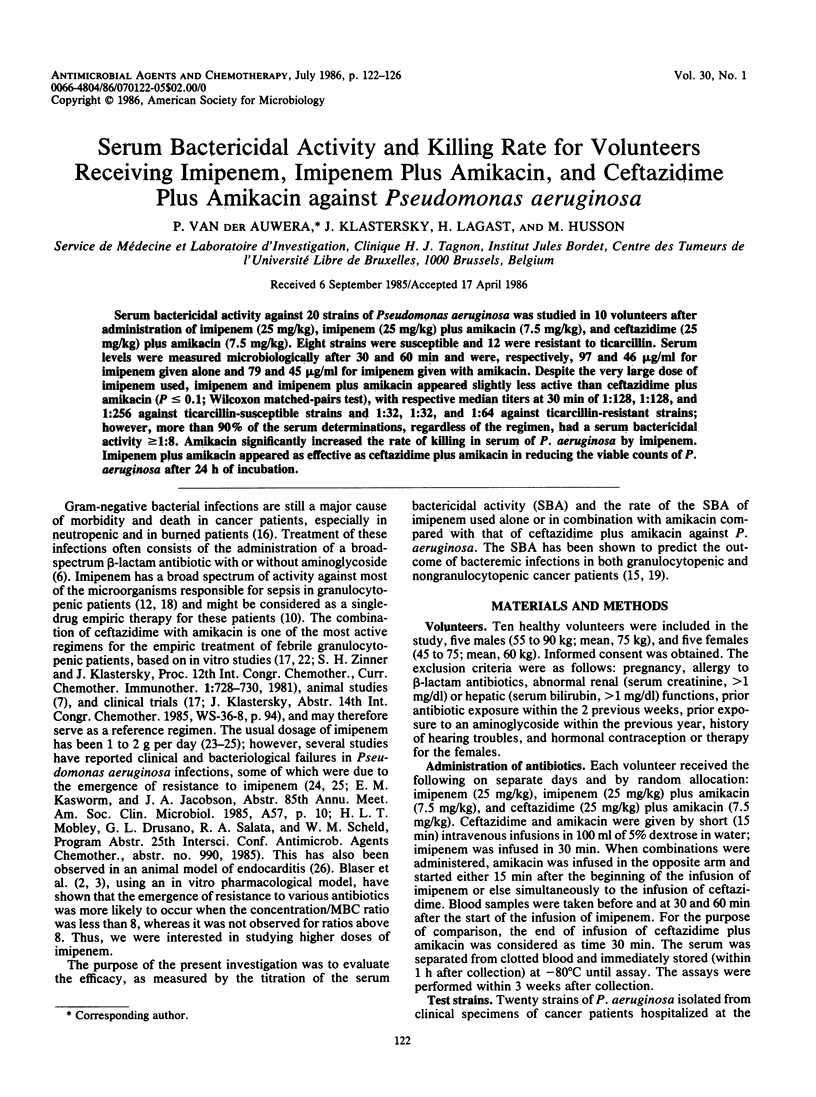
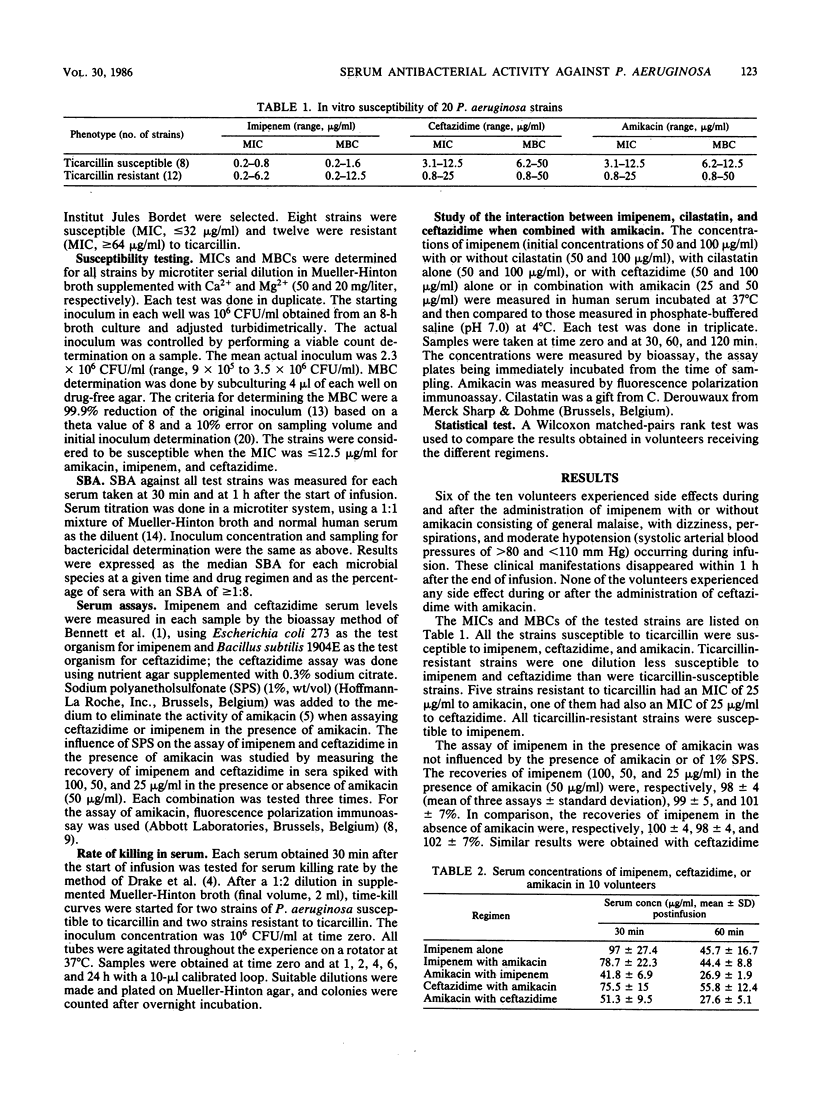
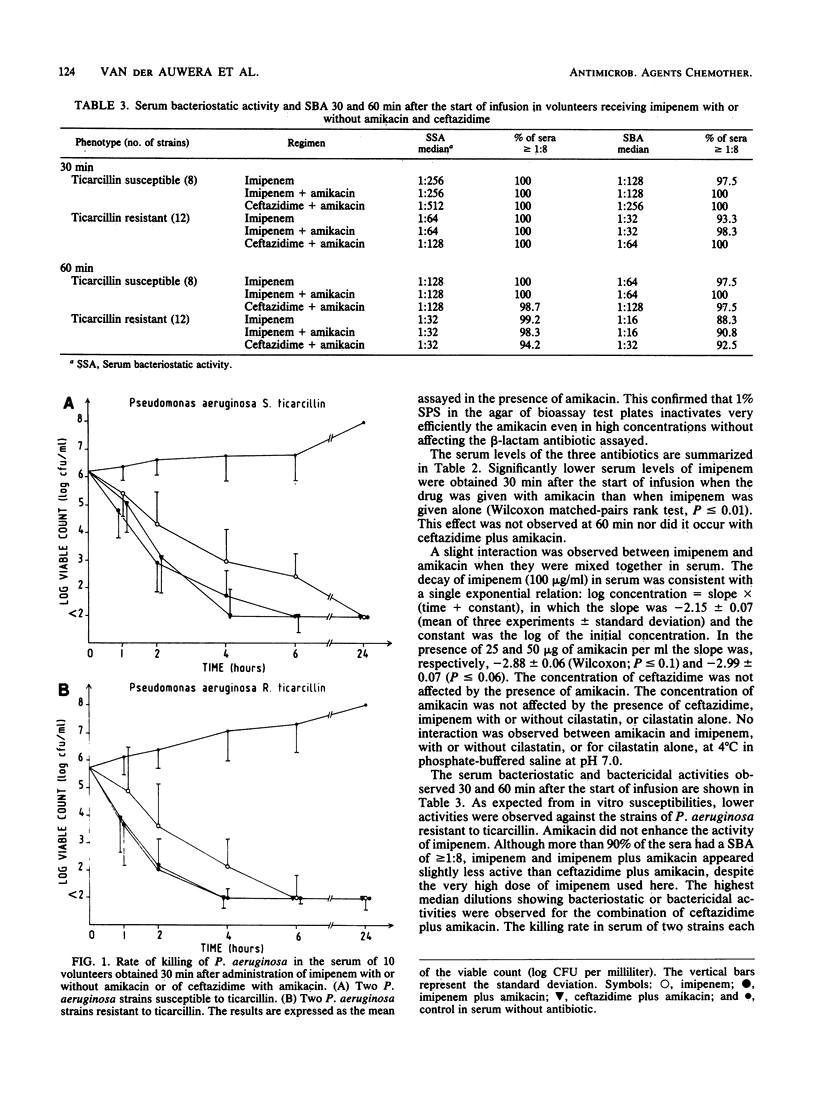
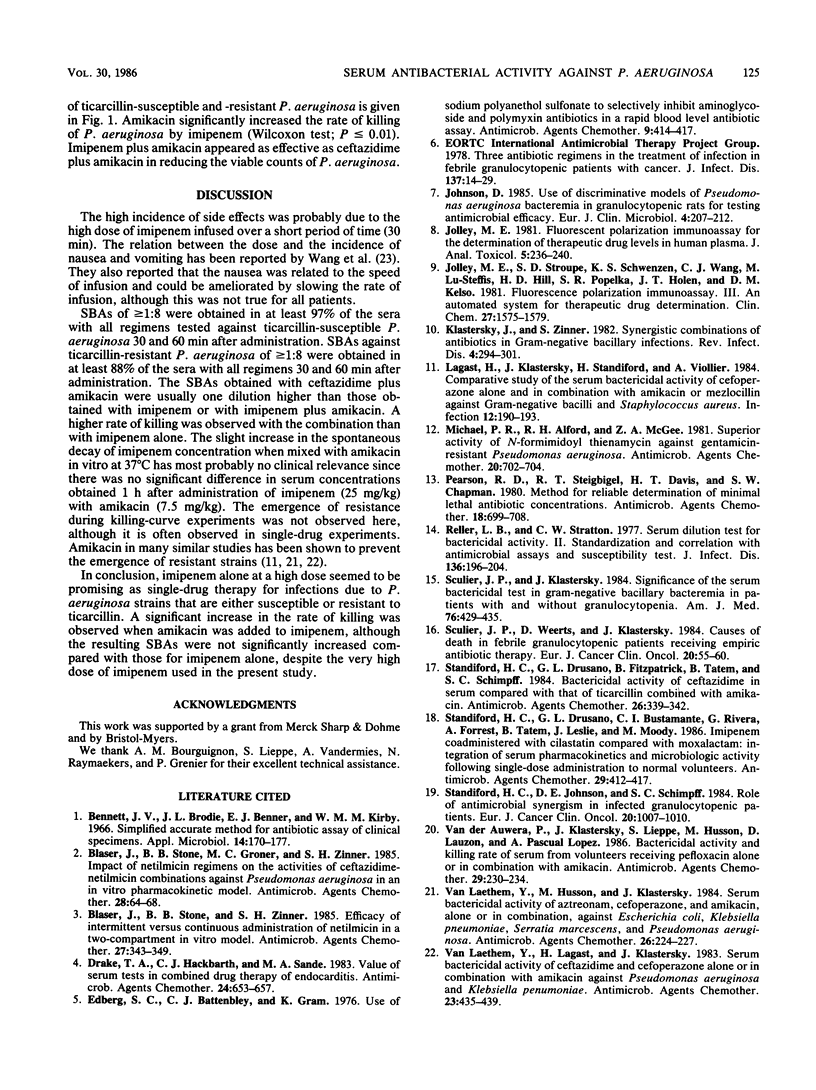
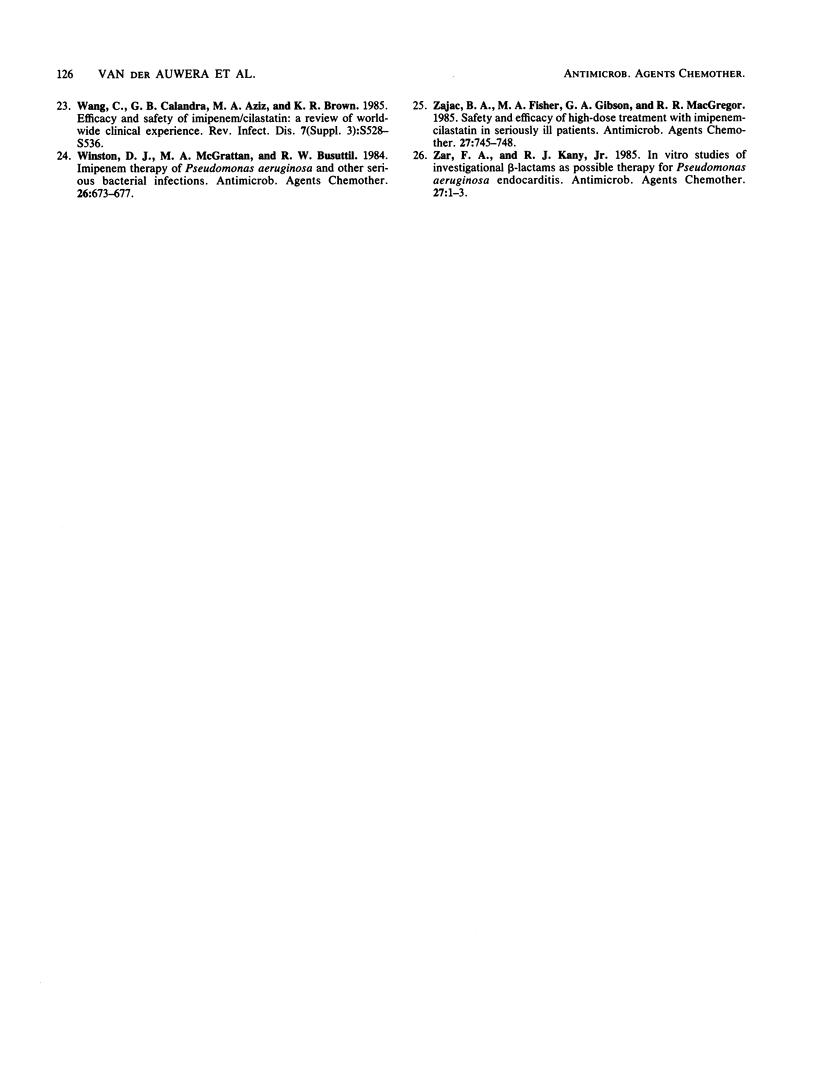
Selected References
These references are in PubMed. This may not be the complete list of references from this article.
- Bennett J. V., Brodie J. L., Benner E. J., Kirby W. M. Simplified, accurate method for antibiotic assay of clinical specimens. Appl Microbiol. 1966 Mar;14(2):170–177. doi: 10.1128/am.14.2.170-177.1966. [DOI] [PMC free article] [PubMed] [Google Scholar]
- Blaser J., Stone B. B., Groner M. C., Zinner S. H. Impact of netilmicin regimens on the activities of ceftazidime-netilmicin combinations against Pseudomonas aeruginosa in an in vitro pharmacokinetic model. Antimicrob Agents Chemother. 1985 Jul;28(1):64–68. doi: 10.1128/aac.28.1.64. [DOI] [PMC free article] [PubMed] [Google Scholar]
- Blaser J., Stone B. B., Zinner S. H. Efficacy of intermittent versus continuous administration of netilmicin in a two-compartment in vitro model. Antimicrob Agents Chemother. 1985 Mar;27(3):343–349. doi: 10.1128/aac.27.3.343. [DOI] [PMC free article] [PubMed] [Google Scholar]
- Drake T. A., Hackbarth C. J., Sande M. A. Value of serum tests in combined drug therapy of endocarditis. Antimicrob Agents Chemother. 1983 Nov;24(5):653–657. doi: 10.1128/aac.24.5.653. [DOI] [PMC free article] [PubMed] [Google Scholar]
- Edberg S. C., Bottenbley C. J., Gam K. Use of sodium polyanethol sulfonate to selectively inhibit aminoglycoside and polymyxin antibiotics in a rapid blood level antibiotic assay. Antimicrob Agents Chemother. 1976 Mar;9(3):414–417. doi: 10.1128/aac.9.3.414. [DOI] [PMC free article] [PubMed] [Google Scholar]
- Johnson D. Use of discriminative models of Pseudomonas aeruginosa bacteremia in granulocytopenic rats for testing antimicrobial efficacy. Eur J Clin Microbiol. 1985 Apr;4(2):207–212. doi: 10.1007/BF02013599. [DOI] [PubMed] [Google Scholar]
- Jolley M. E. Fluorescence polarization immunoassay for the determination of therapeutic drug levels in human plasma. J Anal Toxicol. 1981 Sep-Oct;5(5):236–240. doi: 10.1093/jat/5.5.236. [DOI] [PubMed] [Google Scholar]
- Jolley M. E., Stroupe S. D., Schwenzer K. S., Wang C. J., Lu-Steffes M., Hill H. D., Popelka S. R., Holen J. T., Kelso D. M. Fluorescence polarization immunoassay. iii. an automated system for therapeutic drug determination. Clin Chem. 1981 Sep;27(9):1575–1579. [PubMed] [Google Scholar]
- Klastersky J., Zinner S. H. Synergistic combinations of antibiotics in gram-negative bacillary infections. Rev Infect Dis. 1982 Mar-Apr;4(2):294–301. doi: 10.1093/clinids/4.2.294. [DOI] [PubMed] [Google Scholar]
- Lagast H., Klastersky J., Standiford H., Viollier A. Comparative study of the serum bactericidal activity of cefoperazone alone and in combination with amikacin or mezlocillin against gram-negative bacilli and Staphylococcus aureus. Infection. 1984 May-Jun;12(3):190–193. doi: 10.1007/BF01640897. [DOI] [PubMed] [Google Scholar]
- Michael P. R., Alford R. H., McGee Z. A. Superior activity of N-formimidoyl thienamycin against gentamicin-resistant Pseudomonas aeruginosa. Antimicrob Agents Chemother. 1981 Nov;20(5):702–704. doi: 10.1128/aac.20.5.702. [DOI] [PMC free article] [PubMed] [Google Scholar]
- Pearson R. D., Steigbigel R. T., Davis H. T., Chapman S. W. Method of reliable determination of minimal lethal antibiotic concentrations. Antimicrob Agents Chemother. 1980 Nov;18(5):699–708. doi: 10.1128/aac.18.5.699. [DOI] [PMC free article] [PubMed] [Google Scholar]
- Reller L. B., Stratton C. W. Serum dilution test for bactericidal activity. II. Standardization and correlation with antimicrobial assays and susceptibility tests. J Infect Dis. 1977 Aug;136(2):196–204. doi: 10.1093/infdis/136.2.196. [DOI] [PubMed] [Google Scholar]
- Sculier J. P., Klastersky J. Significance of serum bactericidal activity in gram-negative bacillary bacteremia in patients with and without granulocytopenia. Am J Med. 1984 Mar;76(3):429–435. doi: 10.1016/0002-9343(84)90662-4. [DOI] [PubMed] [Google Scholar]
- Sculier J. P., Weerts D., Klastersky J. Causes of death in febrile granulocytopenic cancer patients receiving empiric antibiotic therapy. Eur J Cancer Clin Oncol. 1984 Jan;20(1):55–60. doi: 10.1016/0277-5379(84)90034-8. [DOI] [PubMed] [Google Scholar]
- Standiford H. C., Drusano G. L., Bustamante C. I., Rivera G., Forrest A., Tatem B., Leslie J., Moody M. Imipenem coadministered with cilastatin compared with moxalactam: integration of serum pharmacokinetics and microbiologic activity following single-dose administration to normal volunteers. Antimicrob Agents Chemother. 1986 Mar;29(3):412–417. doi: 10.1128/aac.29.3.412. [DOI] [PMC free article] [PubMed] [Google Scholar]
- Standiford H. C., Drusano G. L., Fitzpatrick B., Tatem B., Schimpff S. C. Bactericidal activity of ceftazidime in serum compared with that of ticarcillin combined with amikacin. Antimicrob Agents Chemother. 1984 Sep;26(3):339–342. doi: 10.1128/aac.26.3.339. [DOI] [PMC free article] [PubMed] [Google Scholar]
- Standiford H. C., Johnson D. E., Schimpff S. C. Role of antimicrobial synergism in infected granulocytopenic patients. Eur J Cancer Clin Oncol. 1984 Aug;20(8):1007–1010. doi: 10.1016/0277-5379(84)90101-9. [DOI] [PubMed] [Google Scholar]
- Van Laethem Y., Husson M., Klastersky J. Serum bactericidal activity of aztreonam, cefoperazone, and amikacin, alone or in combination, against Escherichia coli, Klebsiella pneumoniae, Serratia marcescens, and Pseudomonas aeruginosa. Antimicrob Agents Chemother. 1984 Aug;26(2):224–227. doi: 10.1128/aac.26.2.224. [DOI] [PMC free article] [PubMed] [Google Scholar]
- Van Laethem Y., Lagast H., Klastersky J. Serum bactericidal activity of ceftazidime and cefoperazone alone or in combination with amikacin against Pseudomonas aeruginosa and Klebsiella pneumoniae. Antimicrob Agents Chemother. 1983 Mar;23(3):435–439. doi: 10.1128/aac.23.3.435. [DOI] [PMC free article] [PubMed] [Google Scholar]
- Van der Auwera P., Klastersky J., Lieppe S., Husson M., Lauzon D., Lopez A. P. Bactericidal activity and killing rate of serum from volunteers receiving pefloxacin alone or in combination with amikacin. Antimicrob Agents Chemother. 1986 Feb;29(2):230–234. doi: 10.1128/aac.29.2.230. [DOI] [PMC free article] [PubMed] [Google Scholar]
- Wang C., Calandra G. B., Aziz M. A., Brown K. R. Efficacy and safety of imipenem/cilastatin: a review of worldwide clinical experience. Rev Infect Dis. 1985 Jul-Aug;7 (Suppl 3):S528–S536. doi: 10.1093/clinids/7.supplement_3.s528. [DOI] [PubMed] [Google Scholar]
- Winston D. J., McGrattan M. A., Busuttil R. W. Imipenem therapy of Pseudomonas aeruginosa and other serious bacterial infections. Antimicrob Agents Chemother. 1984 Nov;26(5):673–677. doi: 10.1128/aac.26.5.673. [DOI] [PMC free article] [PubMed] [Google Scholar]
- Zajac B. A., Fisher M. A., Gibson G. A., MacGregor R. R. Safety and efficacy of high-dose treatment with imipenem-cilastatin in seriously ill patients. Antimicrob Agents Chemother. 1985 May;27(5):745–748. doi: 10.1128/aac.27.5.745. [DOI] [PMC free article] [PubMed] [Google Scholar]
- Zar F. A., Kany R. J., Jr In vitro studies of investigational beta-lactams as possible therapy for Pseudomonas aeruginosa endocarditis. Antimicrob Agents Chemother. 1985 Jan;27(1):1–3. doi: 10.1128/aac.27.1.1. [DOI] [PMC free article] [PubMed] [Google Scholar]


